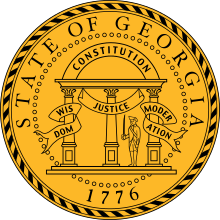George Rockingham Gilmer
| George R. Gilmer | |
|---|---|
 | |
| 34th Governor of Georgia | |
|
In office November 4, 1829 – November 9, 1831 | |
| Preceded by | John Forsyth |
| Succeeded by | Wilson Lumpkin |
|
In office November 8, 1837 – November 6, 1839 | |
| Preceded by | William Schley |
| Succeeded by | Charles J. McDonald |
| Member of the U.S. House of Representatives from Georgia's at-large congressional district | |
|
In office March 4, 1833 – March 3, 1835 | |
| Preceded by | new seat |
| Succeeded by | Seaton Grantland |
| Member of the U.S. House of Representatives from Georgia's 1st congressional district | |
|
In office October 1, 1827 – March 3, 1829 | |
| Preceded by | Edward F. Tattnall |
| Succeeded by | redistricted to at-large |
| Member of the U.S. House of Representatives from Georgia's at-large congressional district | |
|
In office March 4, 1821 – March 3, 1823 | |
| Preceded by | Joel Crawford |
| Succeeded by | George Cary |
| Personal details | |
| Born |
George Rockingham Gilmer April 11, 1790 |
| Died | November 16, 1859 (age 69) |
| Political party |
Democratic-Republican Whig |
| Profession | Soldier, Politician |
George Rockingham Gilmer (April 11, 1790 – November 16, 1859) was an American statesman and politician. He served two non-consecutive terms as the 34th Governor of Georgia, the first from 1829 to 1831 and the second from 1837 to 1839. He also served multiple terms in the United States House of Representatives.
Early life
Gilmer was born near Lexington, Georgia, in what is present day Oglethorpe County (Wilkes County at the time of his birth). He served as first lieutenant in the Forty-third Infantry Regiment from 1813 to 1815 in the campaign against the Creek during the War of 1812. He practiced law as a profession.
Political career
Gilmer's career consisted of multiple, alternating, elected positions at the state and federal level.
He was elected to the Georgia House of Representatives in 1818, 1819, and 1824.
Gilmer was also elected to the U.S. House of Representatives in 1820, 1826, 1828 and 1832. However, he did not serve after the election in 1828 because he failed to accept the position within the legal time frame and the governor ordered a new election.
When he became governor of Georgia, Gilmer initiated the prosecution of Cherokee missionary Samuel Austin Worcester for violation of a law requiring all white persons residing within the Cherokee nation to obtain a license from the governor and to swear to uphold the laws of Georgia. Worcester was arrested in 1831 and sentenced to four years' hard labor. This led to the United States Supreme Court decision Worcester v. Georgia, which struck down the Georgia statute imposing its laws on the Cherokees as violating of the Treaty of Hopewell.
Also of Note
Additional facts of interest concerning George Gilmer:
- Trustee of the University of Georgia (1826–1857)
- Gilmer County, Georgia is named after him.
- Georgia Presidential elector in 1836 and 1840
- Authored Sketches of Some of the First Settlers of Upper Georgia
Death and legacy
Gilmer died in 1859 in Lexington and is buried in the Presbyterian Church Cemetery in the same city. Gilmer County, Georgia is named for him.[1]
Notes
- ↑ Gannett, Henry (1905). The Origin of Certain Place Names in the United States. Govt. Print. Off. p. 137.
References and external links
- George Rockingham Gilmer at the Biographical Directory of the United States Congress Retrieved on 2008-04-28
- This Day in Georgia History:November 15, Ed Jackson and Charly Pou, Carl Vinson Institute of Government, The University of Georgia
- Portrait and Bio at GeorgiaInfo.com
| United States House of Representatives | ||
|---|---|---|
| Preceded by Joel Crawford |
Member of the U.S. House of Representatives from Georgia's at-large congressional district March 4, 1821 – March 3, 1823 |
Succeeded by George Cary |
| Preceded by Edward F. Tattnall |
Member of the U.S. House of Representatives from Georgia's 1st congressional district October 1, 1827 – March 3, 1829 |
Succeeded by Elected at large |
| Preceded by Newly established seat from congressional apportionment |
Member of the U.S. House of Representatives from Georgia's at-large congressional district March 4, 1833 – March 3, 1835 |
Succeeded by Seaton Grantland |
| Political offices | ||
| Preceded by John Forsyth |
Governor of Georgia 1829–1831 |
Succeeded by Wilson Lumpkin |
| Preceded by William Schley |
Governor of Georgia 1837–1839 |
Succeeded by Charles J. McDonald |
| ||||||||||||||||
|
